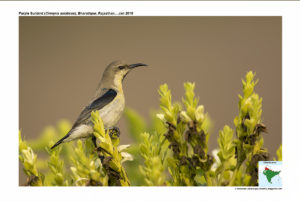Purple Sunbird

Purple Sunbird Cinnyris asiaticus
Etymology :
- Cinnyris : Greek word kinnuris small bird mentioned by Hesychius
- Asiaticus: From Asia
Vernacular Names : Sind: Dunbarg, Hindi: Shakar khora, Phul soongni, Urdu: Shakar khora, Phul soongni, Pun: Kala pidda, Shakar khora, Full sunghni, Bi: Jugi-jugi, M.P.: Sue, Ben: Thun-thuni, Mauchung, Ass: Moupiya sorai, Guj: Phul chakli, Jambli shakkarakhoro, Mar: Chumka, Jambhla suryalakkshi/ Shinjir, Ta: Then-kudi, Pu-kudichan, Te: Thena-pitta, Ooda thene pitta, Mal: Karuppan tenkili, Kan: Makarandaehame, Sinh: Sutikka, Gewal kurulla
Distribution in India: Widespread resident in India.
Description: Size of 10–11 cm; wt. of male is 6·9–11 g, wt. of female is 5–10 g. The male of nominate racein breeding plumage is dark metallic blue and purple above, with uppertail black, glossed blue; metallic purplish-blue on lesser upperwing-coverts, on margins of median and faintly on greater upperwing-coverts and remiges. It is dark metallic blue and purple on throat and breast, sides are blue-green, belly is dark purple and separated from breast by a narrow reddish-brown band, the pectoral tuftsare bright yellow and scarlet. The iris is orange-brown, brown or dark brown; bill is brownish-black, mouth is pinkish-yellow; legs are brownish-black. The male non-breeding is pale olive-brown above, as female, but wings and tail are blackish. It is yellow below, with broad blue-black stripe down middle of throat, breast and belly. The female is olive-brown above, with pale yellowish supercilium, pale fringes on wing feathers, tail is black, outer rectrices are with large white spots; dull yellow below. The juvenile is similar to female, but paler below.
Habitat : It is found around flowering shrubs and trees in dry and deciduous forests, thorn-scrub, cultivation and gardens. It is found from lowlands up to 2100 m.
Food habits: It eats small insects, and spiders; nectar, and fruits. It forages singly or in pairs and in small to medium-sized groups.
Breeding habits: They breed in all months, chiefly in dry season; Jan–Jul in Oman, and Apr–May in Pakistan; May–Aug in North Indian and Nov–Aug in South India, May–Jun in Nepal, Jan–Jun in Sri Lanka, and Feb–May in Myanmar, Feb in Cambodia.The nest is built in 5–15 days. The nest is an oblong purse, usually with porch, made of soft grass and fibres, leaves, cobwebs, etc., decorated with detritus and rubbish, including pieces of bark and caterpillar frass, lined with silky-white seed down; suspended on twig from ground, often from inner branch of bush, or may be hung from trelliswork, creepers, rope, chain, rafter or electric wire or even inside building, or placed among spider nest mass. They lay a clutch of 1–3 eggs. The incubation period is 14–15 days. The nestlingAdult feeding chicks period is 13–17 days. The nests isparasitized by Grey-bellied Cuckoo.